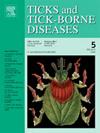Insights into the contribution of multiple factors on Ixodes ricinus abundance across Europe spanning 20 years using different machine learning algorithms
IF 3.4
2区 医学
Q2 INFECTIOUS DISEASES
引用次数: 0
Abstract
The interplay of biotic and abiotic factors driving Ixodes ricinus abundance trends are not fully understood. Machine learning (ML) approaches are being increasingly used to explore this and predict future abundance patterns of this species, however, the studies focusing on this to date have had limitations (including short study duration, limited sample size, narrow geographical range and use of a single ML model). This study was undertaken to address these limitations by applying 11 predictive ML models (across three data clustering techniques) to a large I. ricinus occurrence dataset (27,150 records) containing geographical and temporal data from a 20-year period across 30 European countries, coupled with data covering a range of climatic and habitat features (temperature, rainfall, Normalised Difference Vegetation Index (NDVI), percentage of discontinuous urban fabric and land use category). To assess which ML model was most suited to prediction of I. ricinus abundance, four performance metric values were calculated per model: Normalised Root Mean Square Error (NRMSE), Scatter Index (SI), Mean Absolute Percentage Error (MAPE) and R2, all of which describe the statistical relationship between predicted and actual I. ricinus abundance values. Furthermore, using a Random Forest (RF) model across three clustering methods, we determined which features most significantly impacted upon I. ricinus abundance. The study demonstrated that Agglomerative Hierarchical Clustering (AC) methods and Linear Regression (LR) modelling performed best with this dataset. Our findings revealed that land use and rainfall were the primary contributors to I. ricinus abundance, with temperature playing a lesser role. This was measured according to the extent of prediction error increase following exclusion of that factor from the analysis. We provide a summary of the factors most strongly linked to I. ricinus abundance, which can be used to guide interventions to aid the control of ticks and tick-borne disease across Europe.

使用不同的机器学习算法,深入了解20年来多个因素对欧洲蓖麻伊蚊丰度的贡献。
生物和非生物因素驱动蓖麻蜱丰度趋势的相互作用尚不完全清楚。机器学习(ML)方法被越来越多地用于探索和预测该物种未来的丰度模式,然而,迄今为止的研究都有局限性(包括研究时间短,样本量有限,地理范围狭窄以及使用单一ML模型)。本研究通过将11个预测ML模型(跨越三种数据聚类技术)应用于大型ricinus发生数据集(27,150条记录)来解决这些局限性,该数据集包含30个欧洲国家20年期间的地理和时间数据,以及涵盖一系列气候和栖息地特征的数据(温度,降雨量,标准化差异植被指数(NDVI),不连续城市结构百分比和土地利用类别)。为了评估哪种ML模型最适合预测蓖麻菌丰度,计算了每个模型的四个性能度量值:归一化均方根误差(NRMSE)、散点指数(SI)、平均绝对百分比误差(MAPE)和R2,它们都描述了预测值与实际蓖麻菌丰度值之间的统计关系。此外,通过三种聚类方法使用随机森林(RF)模型,我们确定了哪些特征对蓖麻毒素丰度影响最大。研究表明,聚类分层聚类(AC)方法和线性回归(LR)建模在该数据集上表现最好。研究结果表明,土地利用和降雨是蓖麻毒素丰度的主要影响因素,温度的影响较小。这是根据从分析中排除该因素后预测误差增加的程度来测量的。我们提供了一个与蓖麻毒素丰度最密切相关的因素的总结,这可以用来指导干预措施,以帮助控制整个欧洲的蜱和蜱传疾病。
本文章由计算机程序翻译,如有差异,请以英文原文为准。
求助全文
约1分钟内获得全文
求助全文
来源期刊

Ticks and Tick-borne Diseases
INFECTIOUS DISEASES-MICROBIOLOGY
CiteScore
6.90
自引率
12.50%
发文量
185
审稿时长
6-12 weeks
期刊介绍:
Ticks and Tick-borne Diseases is an international, peer-reviewed scientific journal. It publishes original research papers, short communications, state-of-the-art mini-reviews, letters to the editor, clinical-case studies, announcements of pertinent international meetings, and editorials.
The journal covers a broad spectrum and brings together various disciplines, for example, zoology, microbiology, molecular biology, genetics, mathematical modelling, veterinary and human medicine. Multidisciplinary approaches and the use of conventional and novel methods/methodologies (in the field and in the laboratory) are crucial for deeper understanding of the natural processes and human behaviour/activities that result in human or animal diseases and in economic effects of ticks and tick-borne pathogens. Such understanding is essential for management of tick populations and tick-borne diseases in an effective and environmentally acceptable manner.
 求助内容:
求助内容: 应助结果提醒方式:
应助结果提醒方式:


